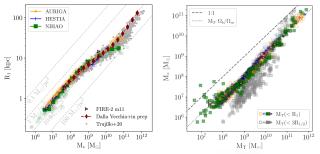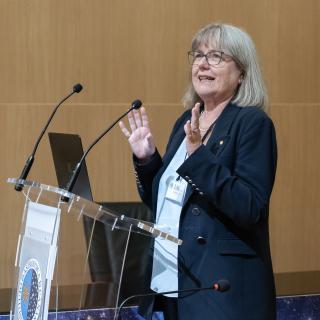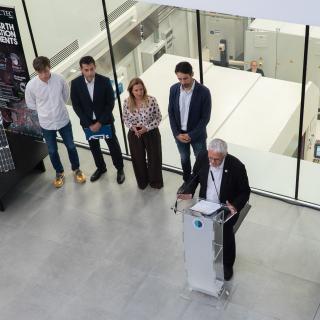Feedback-driven winds from star formation or active galactic nuclei might be a relevant channel for the abrupt quenching of star formation in massive galaxies. However, both observations and simulations support the idea that these processes are non-conflictingly co-evolving and self-regulating. Furthermore, evidence of disruptive events that are capable of fast quenching is rare, and constraints on their statistical prevalence are lacking. Here we present a massive starburst galaxy at redshift z=1.4, which is ejecting ~46% of its molecular gas mass at a startling rate of >10,000 solar masses per year. A broad component that is red-shifted from the galaxy emission is detected in four (low and high J) CO and [C I] transitions and in the ionized phase, which ensures a robust estimate of the expelled gas mass. The implied statistics suggest that similar events are potentially a major star-formation quenching channel. However, our observations provide compelling evidence that this is not a feedback-driven wind, but rather material from a merger that has been probably tidally ejected. This finding challenges some literature studies in which the role of feedback-driven winds might be overstated.
It may interest you
-
 Measuring galaxy sizes is essential for understanding how they were formed and evolved across time. However, traditional methods based on l ight concentration or isophotal densities often lack a clear physical meaning. A recent study from Trujillo+20 explores a more physically motivated definition: the radius R 1, where the stellar surface density falls to 1 solar masses per parsec square —roughly the threshold for gas to form stars in galaxies like the Milky Way. In this work, Arjona-Gálvez+25 uses over 1,000 galaxies from several state-of-the-art cosmological simulations (AURIGA, HESTIAAdvertised on
Measuring galaxy sizes is essential for understanding how they were formed and evolved across time. However, traditional methods based on l ight concentration or isophotal densities often lack a clear physical meaning. A recent study from Trujillo+20 explores a more physically motivated definition: the radius R 1, where the stellar surface density falls to 1 solar masses per parsec square —roughly the threshold for gas to form stars in galaxies like the Milky Way. In this work, Arjona-Gálvez+25 uses over 1,000 galaxies from several state-of-the-art cosmological simulations (AURIGA, HESTIAAdvertised on -
 The Instituto de Astrofísica de Canarias (IAC) has welcomed Donna Strickland, 2018 Nobel Prize in Physics, who delivered a lecture entitled " From Nonlinear Optics to High-Intensity Laser Physics". The talk, held at the IAC Auditorium, was introduced by Garik Israelian, researcher at the center and co-founder of the Starmus Festival, an event in which Strickland participated previously in La Palma last week. During her presentation, Strickland explained in an accessible manner the fundamentals of her pioneering research on Chirped Pulse Amplification (CPA), work for which she was awarded theAdvertised on
The Instituto de Astrofísica de Canarias (IAC) has welcomed Donna Strickland, 2018 Nobel Prize in Physics, who delivered a lecture entitled " From Nonlinear Optics to High-Intensity Laser Physics". The talk, held at the IAC Auditorium, was introduced by Garik Israelian, researcher at the center and co-founder of the Starmus Festival, an event in which Strickland participated previously in La Palma last week. During her presentation, Strickland explained in an accessible manner the fundamentals of her pioneering research on Chirped Pulse Amplification (CPA), work for which she was awarded theAdvertised on -
 La presidenta del Cabildo de Tenerife, Rosa Dávila, ha anunciado esta mañana la aprobación de una subvención de 2,2 millones de euros al Instituto de Astrofísica de Canarias (IAC) para la fabricación de DRAGO-3, una cámara de última generación que se integrará en una constelación global de satélites en órbita baja. Esta red de satélites interconectados está concebida para ofrecer servicios globales o regionales para Tenerife. El importe exacto de la subvención asciende a 2.208.120 euros. El anuncio se ha realizado durante una visita a las instalaciones de IACTEC, la división tecnológica delAdvertised on
La presidenta del Cabildo de Tenerife, Rosa Dávila, ha anunciado esta mañana la aprobación de una subvención de 2,2 millones de euros al Instituto de Astrofísica de Canarias (IAC) para la fabricación de DRAGO-3, una cámara de última generación que se integrará en una constelación global de satélites en órbita baja. Esta red de satélites interconectados está concebida para ofrecer servicios globales o regionales para Tenerife. El importe exacto de la subvención asciende a 2.208.120 euros. El anuncio se ha realizado durante una visita a las instalaciones de IACTEC, la división tecnológica delAdvertised on
